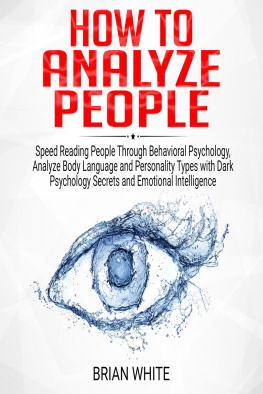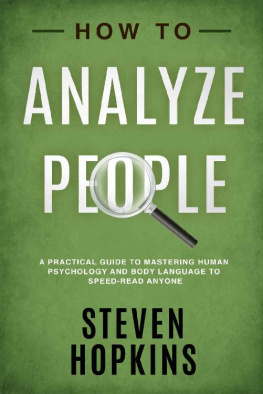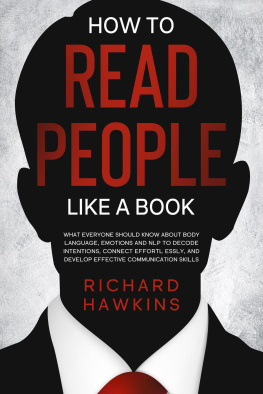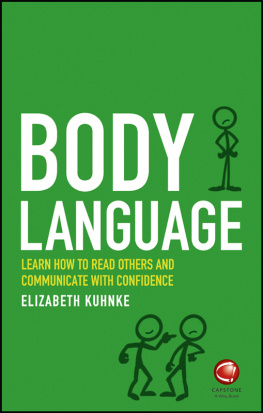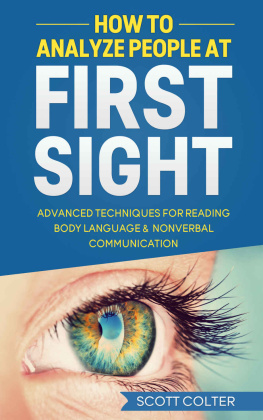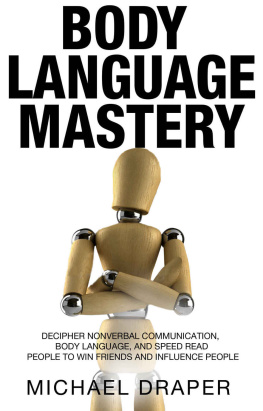Body Language

The words say what is right to say, the body what is true!!
How to Analyze People, Use Powerful Communication, Manipulation and Negotiation Skills to Influence Anyone. Understand Behavioral Psychology to Win in Business and Relationships.
Edward J.P. Aniston
Edward J.P. Aniston Copyright 2019 - All rights reserved.
The content contained within this book may not be reproduced, duplicated or transmitted without direct written permission from the author or the publisher.
Under no circumstances will any blame or legal responsibility be held against the publisher, or author, for any damages, reparation, or monetary loss due to the information contained within this book. Either directly or indirectly.
Legal Notice:
This book is copyright protected. This book is only for personal use. You cannot amend, distribute, sell, use, quote or paraphrase any part, or the content within this book, without the consent of the author or publisher.
Disclaimer Notice:
Please note the information contained within this document is for educational and entertainment purposes only. All effort has been executed to present accurate, up to date, and reliable, complete information. No warranties of any kind are declared or implied. Readers acknowledge that the author is not engaging in the rendering of legal, financial, medical or professional advice. The content within this book has been derived from various sources. Please consult a licensed professional before attempting any techniques outlined in this book.
By reading this document, the reader agrees that under no circumstances is the author responsible for any losses, direct or indirect, which are incurred as a result of the use of information contained within this document, including, but not limited to, errors, omissions, or inaccuracies.
TABLE OF CONTENTS
Introduction
Congratulations on purchasing your copy of Body Language and thank you for doing so.
There are plenty of books on this subject, so thanks again for choosing this one! We made sure that this is the best comprehensive body language guide available on the market, so please enjoy and discover the secret to reading others' thoughts through their gestures and much more!
What separates Homo sapiens from mere animal? Science tells us quite unanimously: : "the ability to communicate. However, we must first distinguish the signals that set humans apart from animals. For example, a single warning call can cause a group of animals to flee.Both humans and animals experience this communication process. The situation is different when the command, "Please follow me to the salon!" causes a group of people to "follow" the speaker, in both meanings of the word. The animals warning call is an analog signal; the above sentence, however, consists of several digital signals. Watzlawicks states that there are basically two types of signals: analog signals that are direct, pictorial, and analogous, and digital signals that are symbolic, abstract, often "complicated," and probably specific to humans.
A child is able to associate the words "Woof woof" and "dog" much faster with the animal, because the "Woof woof" is an analogy to a barking dog. Digital signals have to be laboriously learned before they can be understood and applied. The more your "Woof woof" sounds like barking, the more analogous your signals become. "Dog, on the other hand, is the digital information that is just as little common to the animal it's supposed to describe has, like the words "dog, "chien, or "cane.
Anyone who has not been able to speak the local language abroad knows how direct and problem-free analog communication often is. Let's say you want five packs of cigarettes. You have discovered a brand that you can interpret. So, your body language tells the dealer what you want. You can also display the number analogously by holding up five fingers. Whether the salesman converts this analog signal into "five or something else, i.e. another digital signal, is irrelevant. Your portrayal of five is five-kind, so he understands you. For this, Watzlawicks (88) quotes a brilliant sentence from Bateson and Jackson: "The number five (has) nothing in particular five-fold in itself and the word table has nothing particularly table-like": the human being can communicate both digitally and analogously, although digital signals have to be learned before they can be understood or applied. You can express many things only digitally, and others only analogously. The very fact that man can use both types of communication makes him, in the opinion of science, homo sapiens!
We cannot send content-level signals without "sending in" analog signals from the relational level; no one can speak without a tone of voice, facial expressions, or gestures. Everyone hesitates. We always relay a certain attitude that can be interpreted, and so on.
Therefore, most of us have never learned to perceive signals on the relational level to the same extent. So, we usually miss many signals that could say "more" to us. We usually react unconsciously, intuitively, emotionally to the few analog signals we perceive, right? However, if you learn to consciously direct your attention to these signals, then you will receive two major advantages. First, you will be able to recognize when your relationship with another person is deteriorating, allowing you to intercept and tactically adjust to it. It is probably obvious that this ability can benefit both your professional and personal life!
Second, you will also be able to check your consciously registered observations. So, you will then be able to use a performance control as you learn that analog signals are not always clear. As Watzlawicks (88) points out, the signals "tears," "smiles," or a "clenched fist" are not clearly translated as "pain, "joy, or "combative aggression. Because you can shed tears of joy, you can also smile arrogantly or embarrassedly, and the clenched fist can also show self-discipline and an effort to avoid a fight! The same is true of silence. You can be silent because you think, because you reject a statement, because you hope the other person will speak, because you want to emphasize your next words, or out of insecurity. How easily one can misunderstand analog signals of the body! Well, no more,since you have this book or ebook reader in your hands!
You are now probably starting to wonder the extent to which the knowledge of "body language" from the field of Kinesis is scientifically founded or really proven.
This question conveys a certain need for security. One would like to think that what one knows or is about to learn is "really true. And one often thinks that the label "scientifically proven" can provide a kind of guarantee.
Of course, I try to provide body language information that I think is "safe, which, in my opinion, is most likely "correct. Nevertheless, certain conclusions that I draw may also be wrong. EINSTEIN once wrote in a letter to POPPER that scientific theories are ultimately never logically inferred but can only be invented, and that every scientist or author always creates laws to some extent from facts and observations interpreted and explained in a unique way! Apart from that, mental models do not necessarily have to be "right" to ensure practical and/or material benefits. Many have already sailed for India to arrive instead in America! For example, Newtonian physics not only revolutionized (and falsified) the previous view of the world, but it also stimulated unprecedented developments before EINSTEIN's falsification and improvement of NEWTON's world view brought us a step further.
Perhaps our current approaches in Kinesics are ultimately Newtonian approaches. Maybe tomorrow or the next day an Einstein will come around, who will approach our knowledge differently and, therefore, come to differentiated or completely new approaches. It stands out on the Horizon of interdisciplinary research developments, the one hint at an almost Einstein-like approach! Nevertheless, we can work with our current knowledge in daily practice. NEWTON's physics lasted 200 years and gave many practical advantages before being falsified and improved. Kinesics is only several decades old, but experts have already proven how useful it is when applied to daily practice!
Next page

